India’s architectural landscape is a living museum of diverse traditions, cultural influences, and innovative design philosophies. From the intricate jharokhas of Rajasthan to the serene courtyards of Kerala homes, beautiful houses in India tell stories of heritage, climate adaptation, and artistic expression. These residential masterpieces reflect centuries of cultural exchange, regional craftsmanship, and a harmonious relationship with the natural environment.
As we journey across this vast nation, we’ll discover how traditional wisdom and contemporary vision come together to create spaces that are not just visually stunning but deeply connected to India’s cultural fabric. Whether you’re seeking design inspiration or planning to experience these architectural wonders firsthand, this exploration of India’s most beautiful houses will reveal the soul of Indian residential architecture.
Iconic Regional House Styles Across India
India’s geographical diversity has given rise to distinct architectural traditions, each responding to local climate, available materials, and cultural practices. These regional styles showcase the ingenuity of traditional architects in creating beautiful houses in India that are both functional and aesthetically pleasing.
Traditional Kerala tharavad house with distinctive sloping roof and wooden architecture
Kerala Tharavads: Harmony with Nature
The traditional homes of Kerala, known as tharavads, are architectural poems written in wood and tile. These beautiful houses in India feature sloping roofs designed to withstand heavy monsoon rains, central courtyards (nadumuttam) that facilitate natural ventilation, and elevated foundations that protect against flooding. The liberal use of wood—particularly teak and rosewood—showcases intricate carvings that tell stories of mythology and daily life.
What makes Kerala tharavads truly remarkable is their scientific approach to climate management. The pitched roofs, strategic placement of windows, and open courtyards create a natural cooling system that maintains comfortable indoor temperatures even during hot summers. The sustainable design principles employed centuries ago continue to inspire contemporary architects seeking eco-friendly solutions.
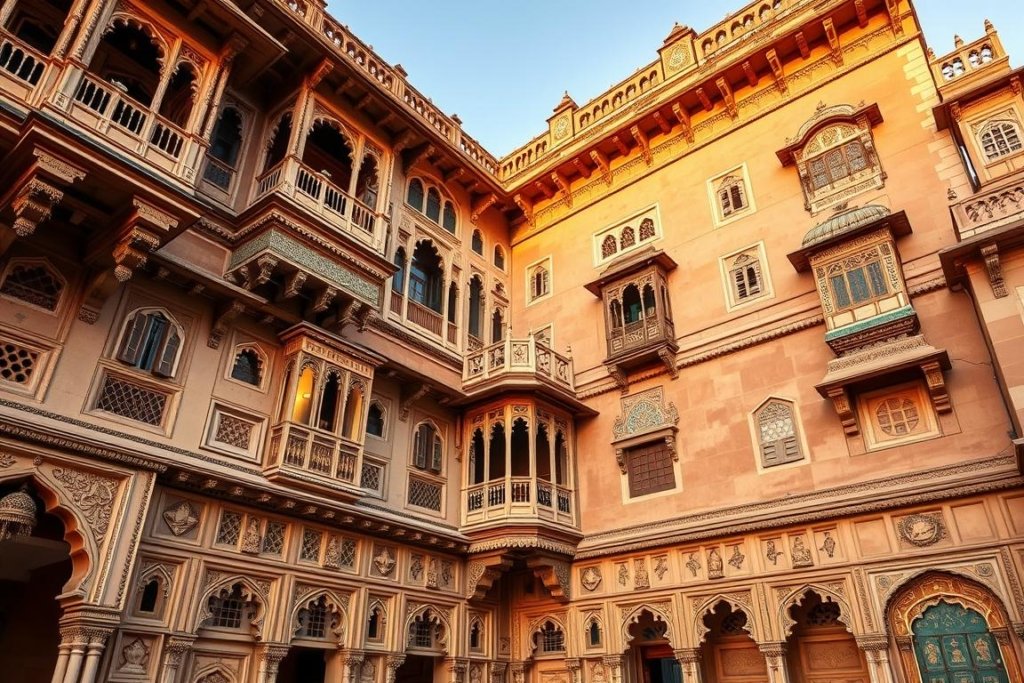
Ornate Rajasthani haveli featuring intricate jharokhas and vibrant frescoes
Rajasthani Havelis: Desert Palaces
In the arid landscapes of Rajasthan, havelis stand as testaments to architectural ingenuity and artistic splendor. These mansion-like structures feature multiple courtyards, intricate jharokhas (overhanging enclosed balconies), and elaborate stone carvings. The facades of these beautiful houses in India are often adorned with vibrant frescoes depicting scenes from mythology, history, and nature.
Rajasthani havelis are masterclasses in desert architecture, with thick walls that insulate against extreme temperatures, small windows that minimize heat gain, and jalis (perforated stone screens) that filter harsh sunlight while ensuring privacy. The multiple courtyards create microclimates within the structure, with water features adding humidity to the dry air.
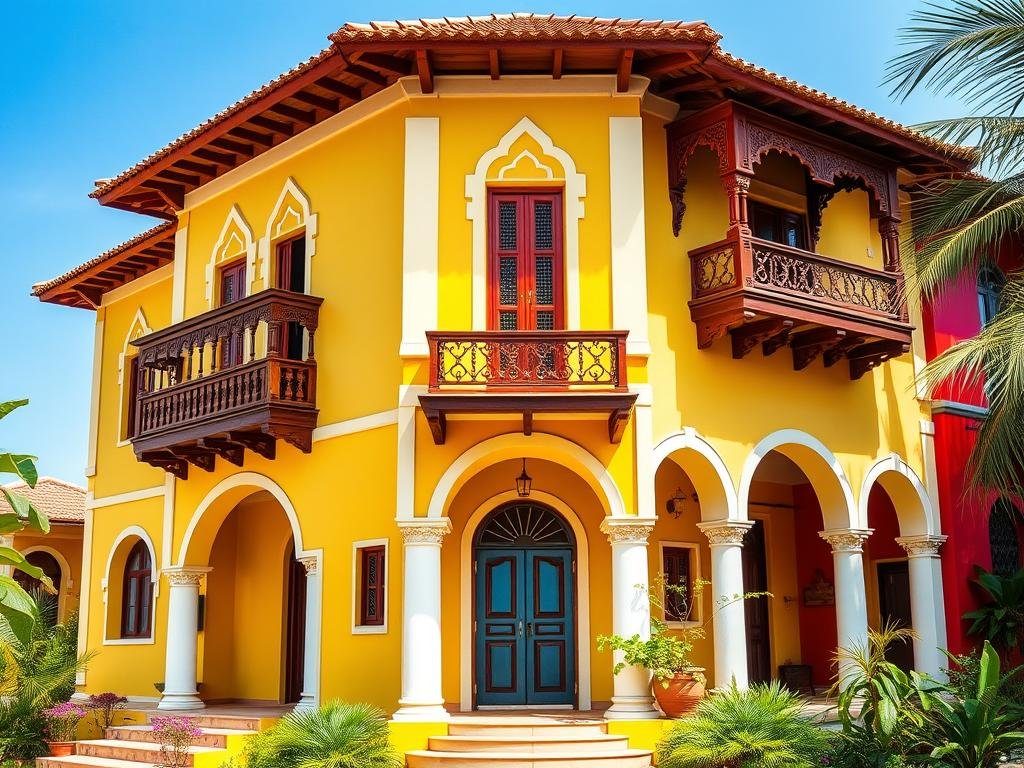
Colorful Goan-Portuguese villa showcasing distinctive Indo-European fusion architecture
Goan-Portuguese Villas: Colonial Fusion
The coastal state of Goa presents a fascinating architectural fusion that blends Portuguese colonial influences with indigenous sensibilities. These beautiful houses in India feature vibrant colored facades, ornate balcões (balconies), oyster shell windows, and central courtyards. The high ceilings, large windows, and verandahs respond perfectly to Goa’s tropical climate.
What distinguishes Goan houses is their seamless integration of European and Indian elements. The layout often follows traditional Hindu spatial concepts while incorporating Portuguese decorative motifs. The result is a unique architectural language that speaks of cultural exchange and adaptation.
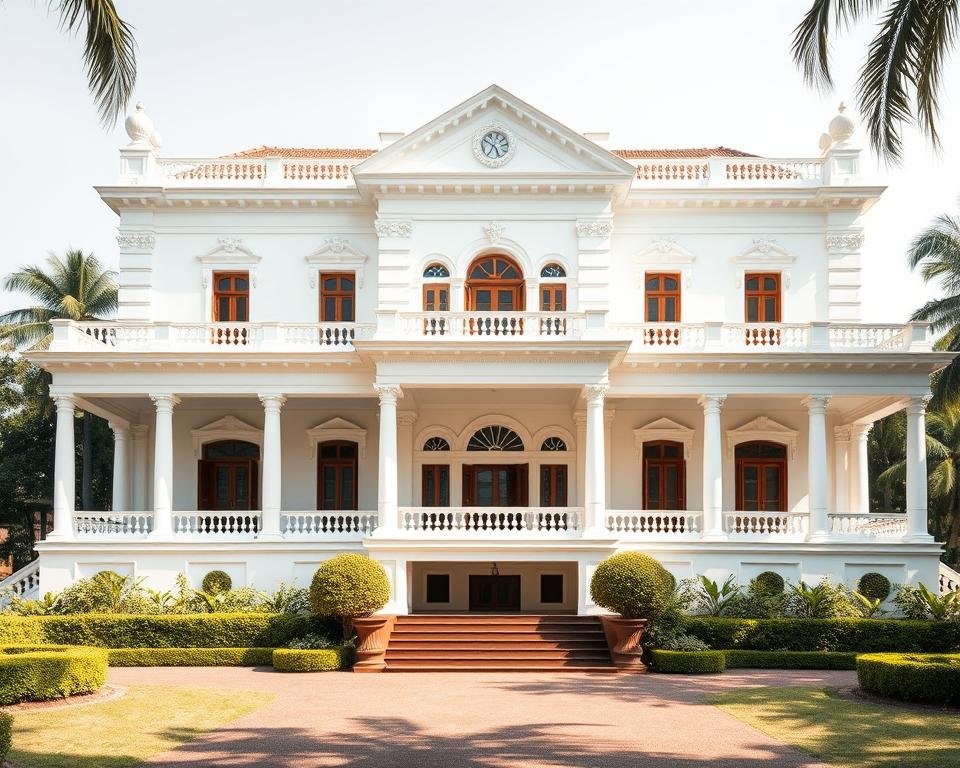
Elegant Bengali colonial mansion with distinctive columned verandah and symmetrical design
Bengali Colonial Homes: Elegant Synthesis
In West Bengal, the traditional homes known as “bonedi bari” represent an elegant synthesis of European colonial architecture and Bengali spatial concepts. These beautiful houses in India typically feature symmetrical designs, columned verandahs (baranda), central courtyards (uthan), and ornate cornices. The layout often includes a thakur dalan (prayer hall) and separate men’s and women’s quarters.
Bengali homes are distinguished by their response to the region’s humid climate, with high ceilings, cross-ventilation, and shaded outdoor spaces. The architectural details often incorporate both classical European elements and traditional Bengali motifs, creating a unique visual language.
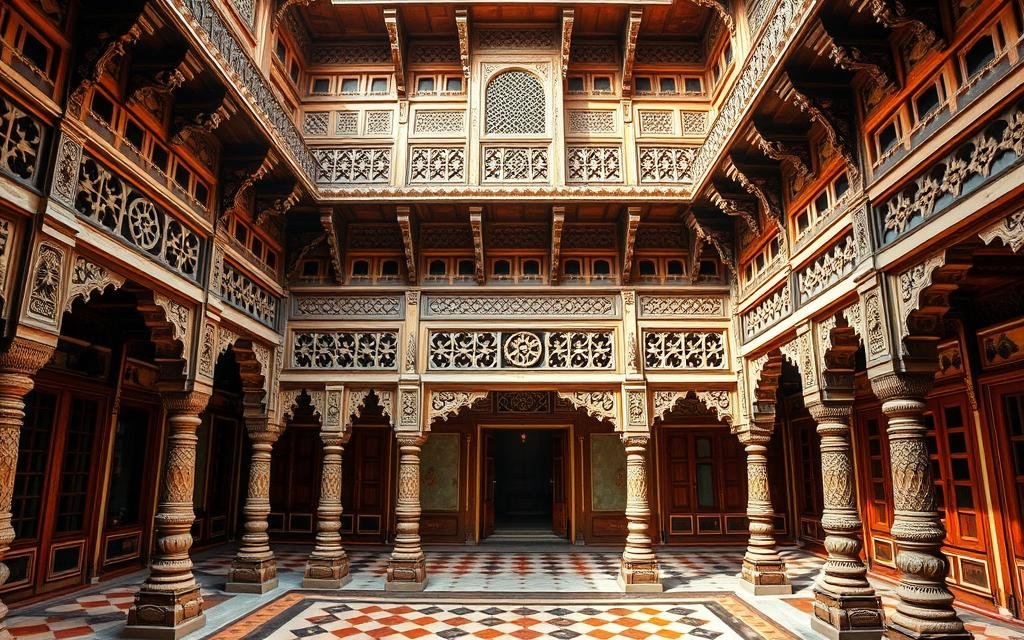
Traditional Gujarati haveli showcasing intricate wooden carvings and colorful courtyard
Gujarati Havelis: Wooden Wonders
Gujarat’s traditional homes are celebrated for their extraordinary woodwork and spatial organization. These beautiful houses in India feature elaborately carved wooden facades, ornate brackets, and internal courtyards that facilitate cross-ventilation. The typical Gujarati haveli is organized around one or more courtyards, with the ground floor dedicated to business activities and upper floors to family living.
What makes these structures remarkable is the intricate wooden craftsmanship that adorns every element—from facades and columns to doors and window frames. The carvings often depict floral motifs, mythological scenes, and geometric patterns, showcasing the region’s rich artistic traditions.
Experience Traditional Indian Architecture Firsthand
Many of these historical homes have been converted into heritage hotels and homestays, offering a unique opportunity to experience traditional Indian architecture from the inside.
Modern Luxury Homes: Tradition Meets Innovation
Contemporary architects in India are creating stunning residences that honor traditional principles while embracing modern aesthetics and technologies. These beautiful houses in India demonstrate how cultural heritage can inform cutting-edge design.
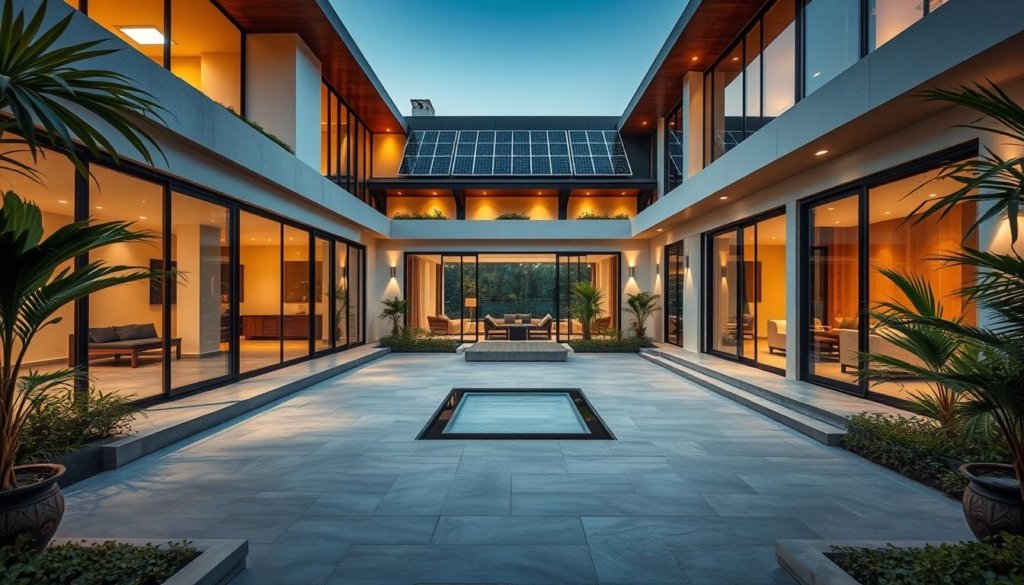
Contemporary luxury home in Bengaluru blending modern design with traditional courtyard concept
The Palimpsest House, Madurai
Inspired by Geoffrey Bawa’s tropical modernism, this stunning residence in Madurai reinterprets traditional Tamil spatial concepts for contemporary living. The home features an inward-looking design with multiple courtyards, creating a microclimate that mitigates Madurai’s extreme heat. Natural materials like exposed brick, polished cement, and local stone connect the structure to its context.
What makes this among the beautiful houses in India is its layered approach to design—hence the name “Palimpsest”—where each space reveals traces of traditional architecture while embracing modern functionality. The home demonstrates how climate-responsive design principles from vernacular architecture can be applied to contemporary contexts.
Crystal Hall, Bengaluru
This innovative residence in Bengaluru represents the cutting edge of sustainable luxury. The minimalist structure features double-layered glass for thermal insulation, residential windmill towers for energy generation, and a sophisticated water management system. The centerpiece is a stunning double helix glass staircase that serves as both functional element and sculptural focal point.
Despite its contemporary appearance, Crystal Hall draws inspiration from traditional Indian concepts of space and light. The home’s meditative landscape and thoughtful orientation echo ancient vastu principles, creating harmony between built form and natural environment.
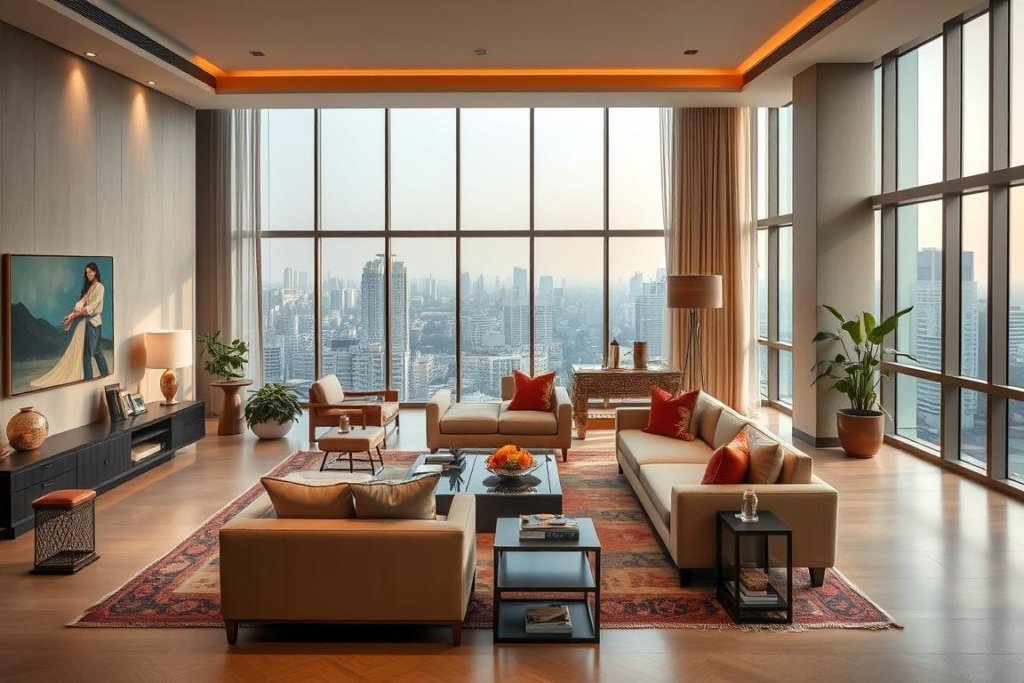
Modern Mumbai apartment showcasing fusion of contemporary design with traditional Indian art
Art Collector’s Home, Chennai
This remarkable Chennai residence was designed specifically around its owner’s art collection. The home features fluid, amorphous spaces with curved walls finished in concrete. Large openings frame views of the river, while carefully positioned skylights create dramatic light effects that change throughout the day.
What places this among the beautiful houses in India is its approach to displaying art—the architecture itself becomes a canvas, with spaces designed to highlight specific pieces. Traditional materials like polished cement are reimagined in contemporary forms, creating a dialogue between past and present.
The Mango House, Alibaug
Designed by acclaimed architect Bijoy Jain, this eco-friendly residence in Alibaug demonstrates how contemporary architecture can honor the natural landscape. Built around existing mango trees, the home features locally sourced materials, traditional craftsmanship, and passive cooling strategies.
The beauty of this house lies in its restraint—simple forms, honest materials, and thoughtful detailing create spaces of remarkable serenity. The design draws on traditional wisdom about climate response while achieving a distinctly contemporary aesthetic.
Bring Indian Design Elements Into Your Home
Inspired by these modern interpretations of traditional Indian architecture? Connect with designers who specialize in adapting Indian design elements for contemporary contexts.
Key Elements That Define Beautiful Houses in India
Across the diverse architectural traditions of India, certain design elements consistently appear, contributing to the unique character of beautiful houses in India. These elements reflect both aesthetic preferences and practical responses to climate and lifestyle.
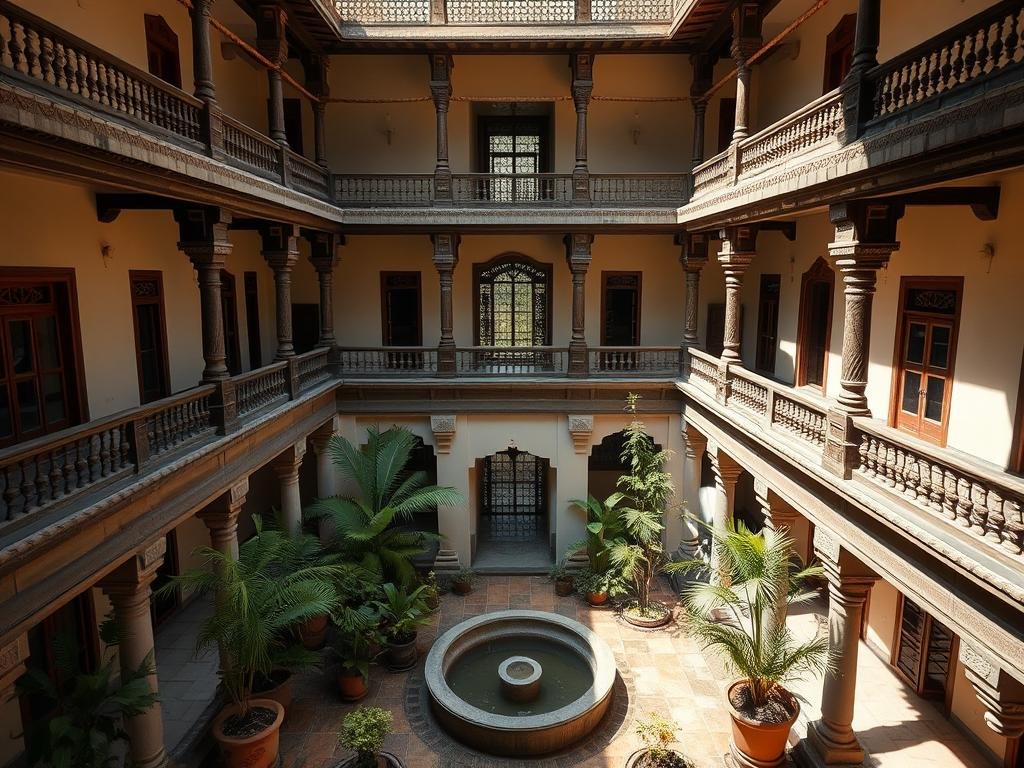
Traditional Indian courtyard house showcasing the central open space that organizes the home
Courtyard Designs: The Heart of the Home
The courtyard (known variously as aangan, chowk, nadumuttam, or uthan) is perhaps the most defining feature of traditional Indian homes across regions. These central open spaces serve multiple functions—they bring light and ventilation into the home, create gathering spaces for family activities, and establish a connection with the sky and elements.
In contemporary interpretations, courtyards continue to play a vital role in beautiful houses in India, though often reimagined with water features, sculptural elements, or specialized landscaping. The enduring popularity of courtyard designs speaks to their effectiveness in creating comfortable, connected living environments.
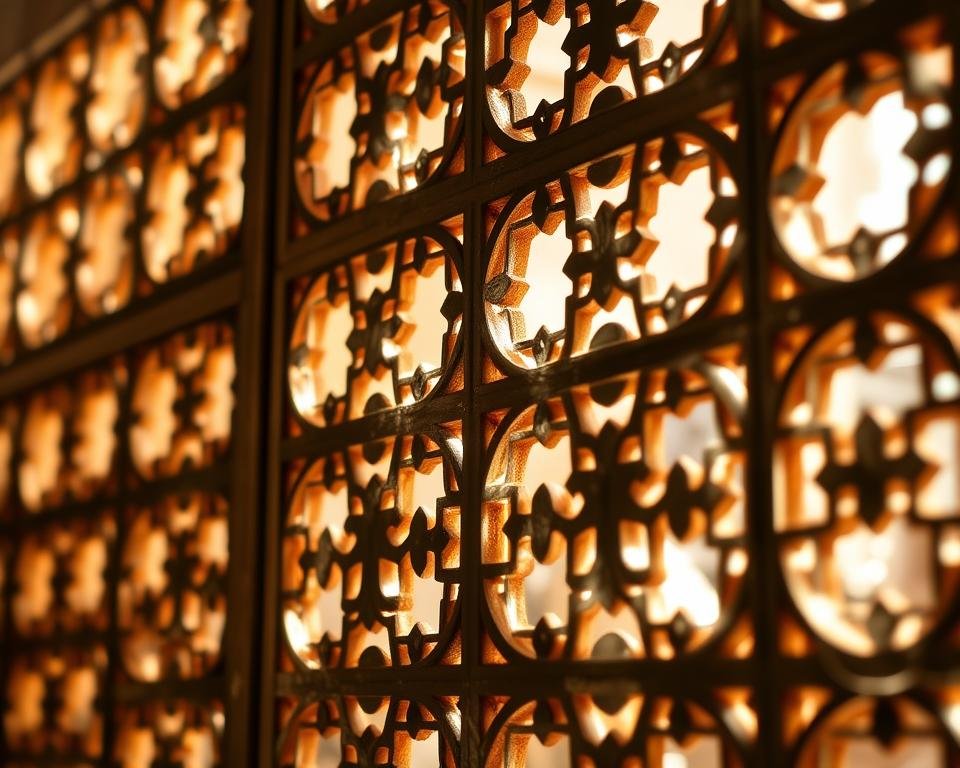
Intricate jali work creating beautiful filtered light patterns in an Indian home
Jali Work: Functional Artistry
Jalis—perforated stone or wooden screens—are another signature element of beautiful houses in India. These intricate screens serve multiple purposes: they filter harsh sunlight, facilitate air circulation, provide privacy, and create mesmerizing light patterns that animate interior spaces throughout the day.
The geometric patterns of jalis often carry symbolic significance, with designs inspired by cosmic patterns, floral motifs, or calligraphy. In contemporary homes, jalis are being reinvented with modern materials and manufacturing techniques, though they retain their essential functions and aesthetic appeal.
Vibrant Color Palettes: Celebrating Life
India’s residential architecture is renowned for its bold use of color. From the blue houses of Jodhpur to the pastel facades of Goan villas and the vibrant interiors of Gujarati homes, color is used to express identity, respond to climate conditions, and create visual delight.
These color traditions continue in many beautiful houses in India today, though often with contemporary interpretations. Modern architects might use color more selectively, creating focal points or highlighting architectural elements rather than applying it comprehensively.
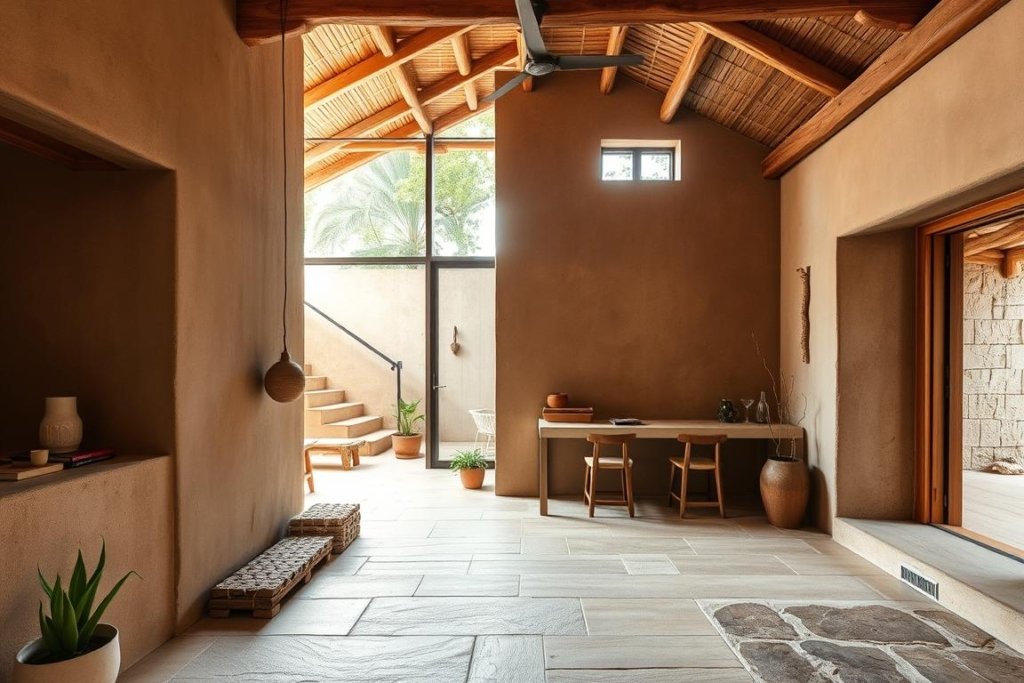
Sustainable materials in a modern Indian home including rammed earth walls and bamboo elements
Sustainable Materials: Building with the Earth
Traditional Indian architecture has always emphasized locally available, sustainable materials—mud, stone, wood, lime, and thatch. These materials not only connect buildings to their geographical context but also provide excellent thermal performance in India’s varied climates.
Contemporary beautiful houses in India are revisiting these traditional materials, often combining them with modern technologies to enhance performance. Rammed earth, compressed stabilized earth blocks, bamboo, and reclaimed wood are finding new expressions in luxury homes, contributing to both sustainability and aesthetic richness.
Courtyards
Central open spaces that bring light, air, and nature into the heart of the home while creating gathering spaces for family activities.
Jali Work
Perforated screens that filter light, enhance ventilation, ensure privacy, and create beautiful shadow patterns throughout the day.
Verandahs
Covered outdoor spaces that provide shade, facilitate social interaction, and create transition zones between interior and exterior.
Water Features
Pools, fountains, and stepwells that cool surrounding air, create visual focal points, and often carry spiritual significance.
Carved Elements
Intricate woodwork, stone carvings, and decorative details that showcase craftsmanship and tell cultural stories through visual language.
Natural Materials
Local stone, wood, earth, and plant-based materials that connect buildings to their environment and regulate indoor climate naturally.
Cultural and Environmental Influences on Indian Homes
The extraordinary diversity of beautiful houses in India cannot be understood without considering the cultural, climatic, and historical factors that have shaped them. These influences have created distinctive regional styles while contributing to a rich national architectural vocabulary.
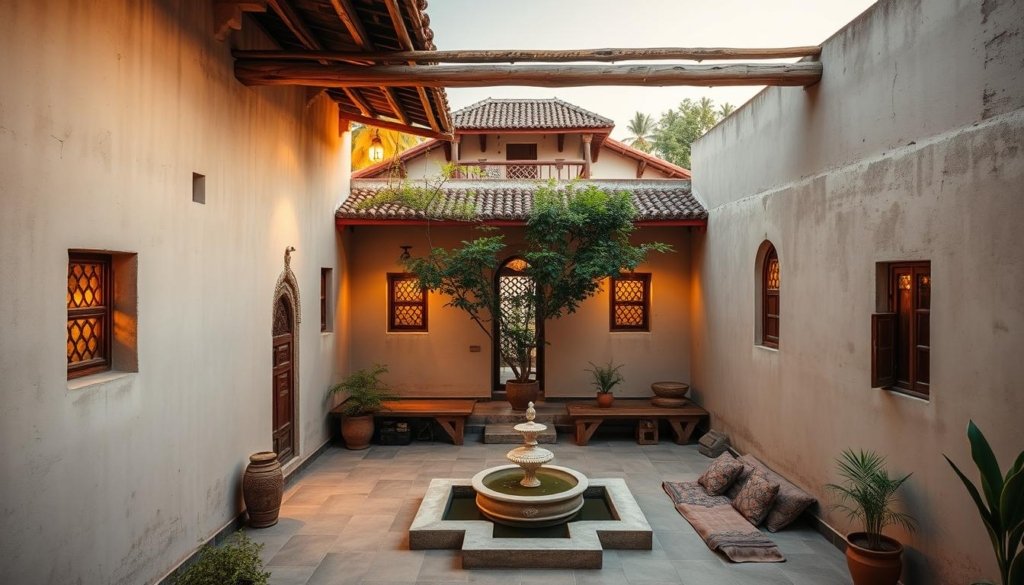
Traditional Indian home showcasing climate-adaptive features for hot weather regions
Climate Adaptation: Building for Comfort
India’s varied climate zones—from the arid deserts of Rajasthan to the humid tropics of Kerala and the cold mountains of the Himalayas—have necessitated different architectural responses. Beautiful houses in India demonstrate sophisticated passive cooling and heating strategies developed over centuries.
In hot, dry regions, homes feature thick walls, small windows, and internal courtyards that create cool microclimates. In humid areas, elevated structures, large openings, and steep roofs facilitate air movement and rain protection. These climate-responsive designs achieve comfort with minimal resource consumption, offering valuable lessons for sustainable architecture today.
Local Crafts: Architecture as Artisanship
India’s rich craft traditions have profoundly influenced its residential architecture. Regional specializations in woodcarving, stonework, plasterwork, and painting are prominently displayed in beautiful houses in India, with each region developing distinctive decorative languages.
The involvement of skilled artisans in building processes has created homes that are not just functional shelters but expressions of cultural identity and artistic achievement. Contemporary architects are finding new ways to incorporate these craft traditions, supporting artisan communities while creating uniquely Indian modern spaces.
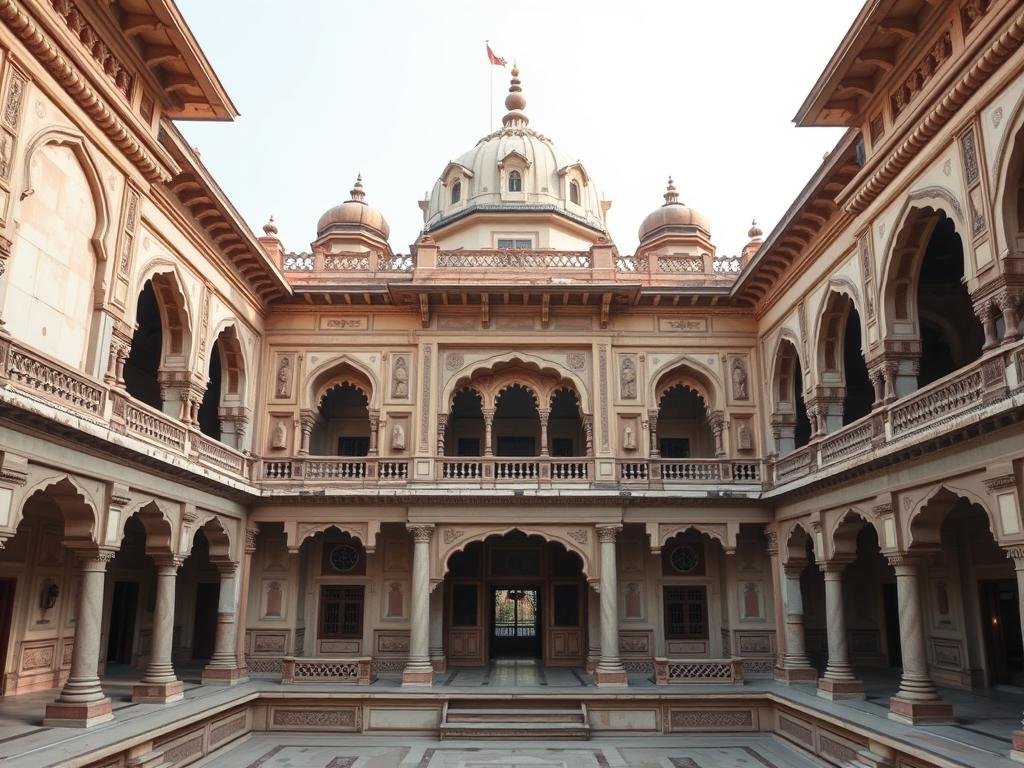
Architectural fusion showing Mughal, colonial and indigenous elements in an Indian home
Historical Influences: Layers of Heritage
India’s complex history of cultural exchange—through trade, conquest, and migration—has enriched its architectural vocabulary. Beautiful houses in India often display multiple historical influences seamlessly integrated into cohesive designs.
Mughal elements like cusped arches and charbaghs, European features like classical columns and pitched roofs, and indigenous traditions like courtyards and verandahs coexist in many regional styles. This architectural syncretism reflects India’s ability to absorb and transform external influences while maintaining cultural continuity.
Explore Virtual Tours of Indian Architectural Treasures
Experience the beauty and diversity of Indian residential architecture through immersive virtual tours of heritage homes across the country.
Practical Tips for Experiencing and Drawing Inspiration from Indian Homes
Whether you’re planning to visit beautiful houses in India or seeking to incorporate Indian design elements into your own home, these practical tips will help you make the most of India’s rich architectural heritage.
For Travelers: Experiencing Architectural Heritage
- Stay in heritage properties that have been converted into hotels or homestays for an immersive experience of traditional architecture.
- Visit during regional festivals when many private homes and palaces open their doors to visitors.
- Join architectural walking tours in historic districts of cities like Jaipur, Ahmedabad, and Pondicherry.
- Respect privacy when photographing occupied homes, and always ask permission before entering private properties.
- Engage with local guides who can explain the cultural significance and technical features of regional architectural styles.
For Homeowners: Drawing Design Inspiration
- Focus on principles rather than direct replication—adapt Indian design concepts to your climate and lifestyle.
- Consider incorporating a small courtyard, light well, or atrium to bring natural light and ventilation into your home.
- Use jali-inspired screens as room dividers or window treatments to filter light and create privacy.
- Introduce handcrafted elements like carved wooden details, hand-painted tiles, or textured wall finishes.
- Experiment with color in specific areas—an accent wall, door, or ceiling—rather than overwhelming the space.
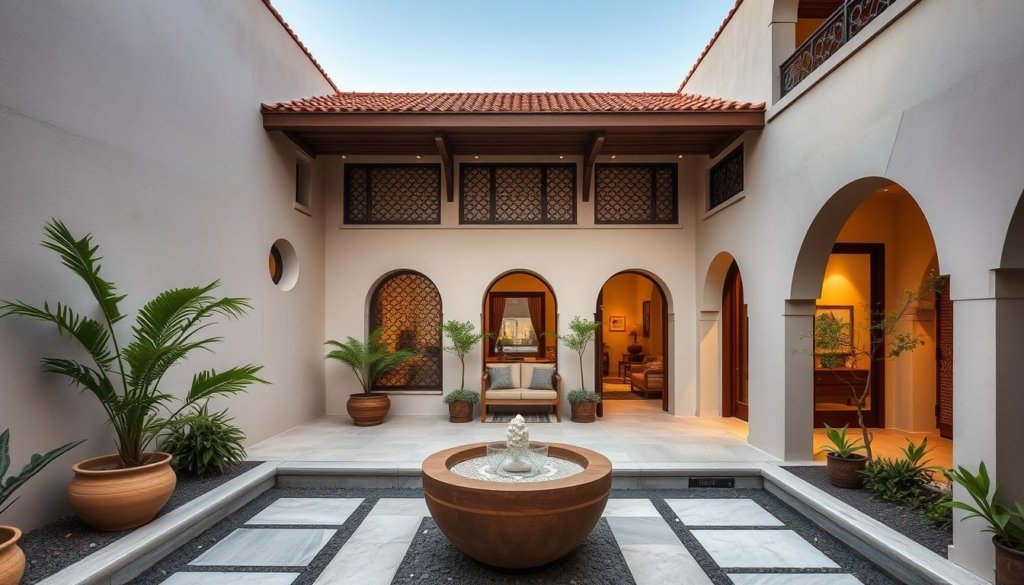
Contemporary home incorporating Indian-inspired design elements in a modern context
Plan Your Architectural Journey Through India
Discover curated architectural tours that take you through India’s most beautiful residential treasures, from palatial havelis to humble yet ingenious village homes.
Celebrating the Beauty and Wisdom of Indian Residential Architecture
The beautiful houses in India we’ve explored represent more than just aesthetic achievements—they embody centuries of accumulated wisdom about living harmoniously with climate, culture, and community. From the scientific brilliance of passive cooling systems to the artistic splendor of decorative crafts, Indian residential architecture offers valuable lessons for contemporary design worldwide.
As global challenges like climate change and resource scarcity become more pressing, the sustainable principles embedded in traditional Indian homes—efficient use of local materials, climate-responsive design, and integration with natural systems—become increasingly relevant. At the same time, the cultural richness and artistic expression found in these homes remind us that architecture is not just about solving technical problems but about creating spaces that nurture the human spirit.
Whether you’re an architecture enthusiast, a traveler seeking authentic experiences, or a homeowner looking for design inspiration, India’s residential treasures offer endless opportunities for discovery and appreciation. By understanding and celebrating these beautiful houses in India, we contribute to preserving architectural heritage while inspiring new generations of sustainable, culturally rooted design.




